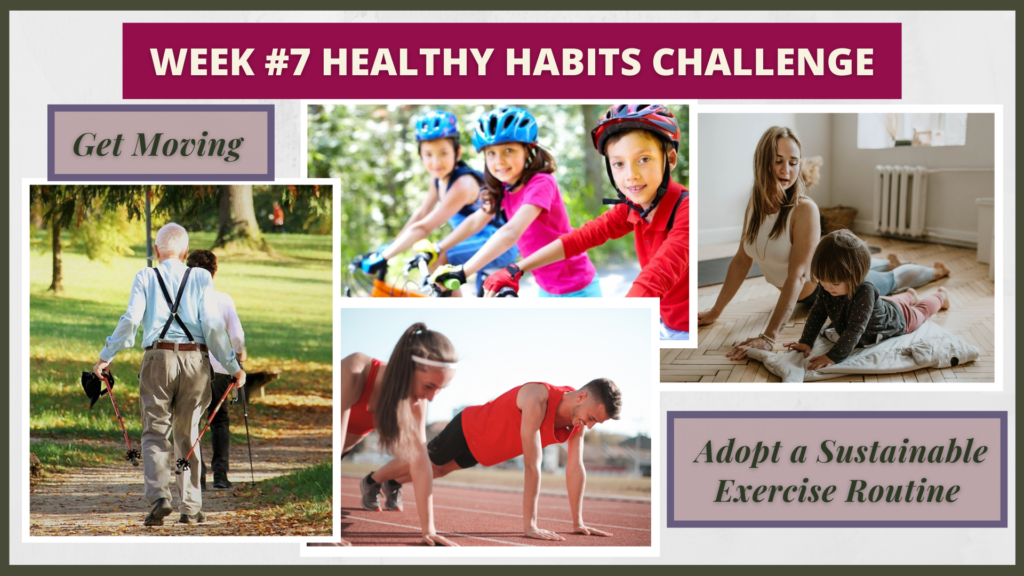Join our mailing list to receive the latest health tips and updates.
You have Successfully Subscribed!
Week #7 Healthy Habits Challenge – Get moving, Adopt a Sustainable Exercise Routine

Welcome to Week #7 of the 12-Week Healthy Habits Challenge!
We all probably know that regular physical exercise is good for health.
Scientific research has shown that regular and adequate levels of physical activity/exercise can reduce the risks and manage chronic diseases/disorders including obesity, high blood pressure, type 2 diabetes, heart disease, cancer, osteoporosis and osteopenia, Alzheimer’s disease, and dementia.
Regular exercise also improves immune health, brain health, mental health and sleep, reduces stress, and supports hormonal balance.
However, it is important to note that in terms of health benefits, it is not the longer or the higher the intensity of physical exercise the better.
To reap the health benefits of physical exercise, here are what scientific research has shown in terms of adequate levels and forms of exercise:
- Any physical exercise/activity is better than none.
- Optimal level of aerobic exercise per week, spread across 3 or more days: 150 – 300 minutes of moderate intensity physical exercise/activity (e.g., brisk walking or jogging 3-4 mph, slow-paced stair climbing, moderate-paced cycling, higher intensity yoga or Pilates, etc.); OR 75-150 minutes of vigorous intensity physical exercise/activity (e.g., jogging/running at > 4 mph, fast-paced stair climbing, fast-paced cycling, etc.)
- In addition to aerobic exercise, for overall health, adopt an all-rounded exercise regimen that includes different forms of exercise including strength/resistance training, stretching/flexibility training, balance exercise, and posture exercise. Such an all-rounded exercise regimen can improve health, reduce risk of fall and injury, and reduce risk of age-related postural stoop, mobility decline and debility.
- Stretching exercise can be as effective or more effective than moderate intensity aerobic exercise in reducing blood pressure and blood glucose levels, when done regularly, i.e., ~30-minute, 3 to 5 times a week.
(For more details and the relevant scientific references, please check out my previous articles here:
Health Benefits of Physical Exercise That May Surprise You
Choosing the Right Types of Exercise for Your Immune Health
Let’s Stretch – For Your Health)
The above are general guidelines for adults. It is important to note that one should always choose the levels and forms of physical exercise based on one’s health conditions and fitness level.
To reap the health benefits of physical exercise, consistency is the key. Please continue reading the next section for some tips on maintaining a regular exercise routine.
Tips to Maintain a Sustainable Exercise Routine
Here are some tips that may help to maintain a regular and sustainable exercise routine:
- Keep in mind that any physical exercise (or physical activity) is better than none. So, aim for progress, rather than perfection.
- Although it may be good to target the optimal levels and forms of physical exercise each week (e.g., 150 minutes of moderate intensity aerobic exercise each week) as discussed above, it is important not to be bogged down by the “all or nothing” mindset. Whenever you can fit in some physical exercise (even just for a short duration such as 10-15 minutes) into your busy schedule, it is good.
- Plan your work and personal life schedule accordingly such that there are some dedicated time slots each week reserved for physical exercise. Prioritize your health and well-being, and make sure these dedicated time slots will not be occupied by other appointments.
- Choose the types of physical exercise that you are interested in and enjoy doing, so that exercise can be fun rather than a chore. Exercise with a friend or partner for mutual support and encouragement.
- Try to incorporate different forms of exercise including aerobic, strength training, stretching, etc. as discussed above for the various health benefits.
- The goal is to be physically active rather than sedentary. Physical activity does not have to be limited to those formal forms of physical exercise. For example, household work, gardening or yard work, depending on the intensity levels, can be considered as moderate to high intensity physical activity. Other examples include climbing the stairs instead of taking the elevator, finding opportunities to walk rather than driving your car whenever possible.
Join me for this week’s challenge and adopt a regular and sustainable exercise routine.
Related Articles
Health Benefits of Physical Exercise That May Surprise You
